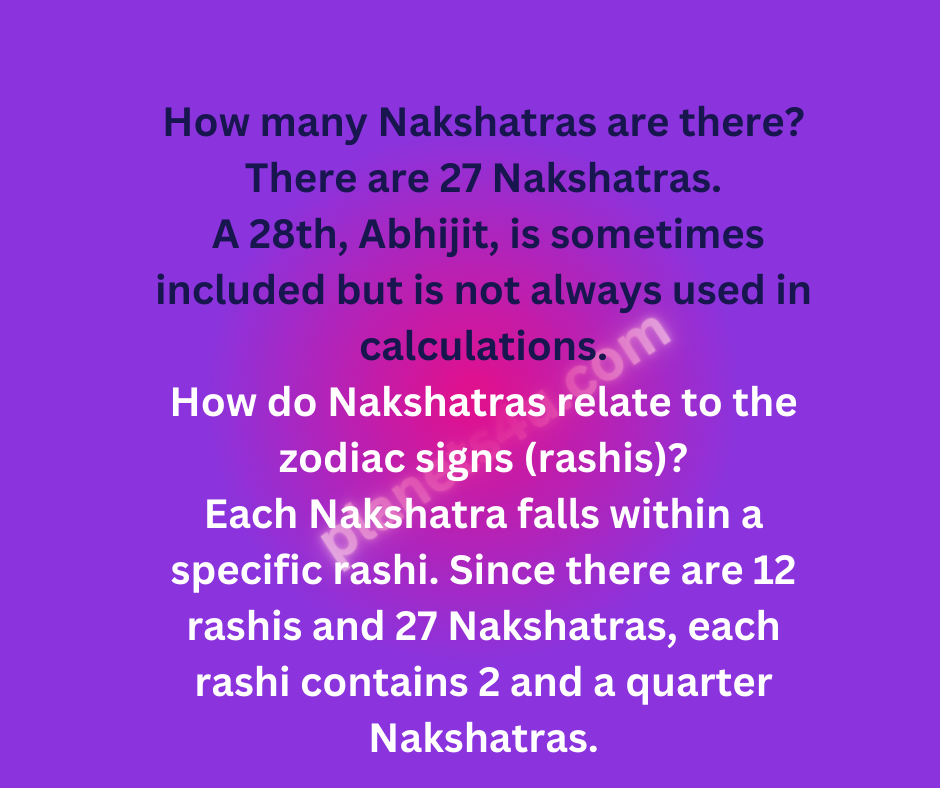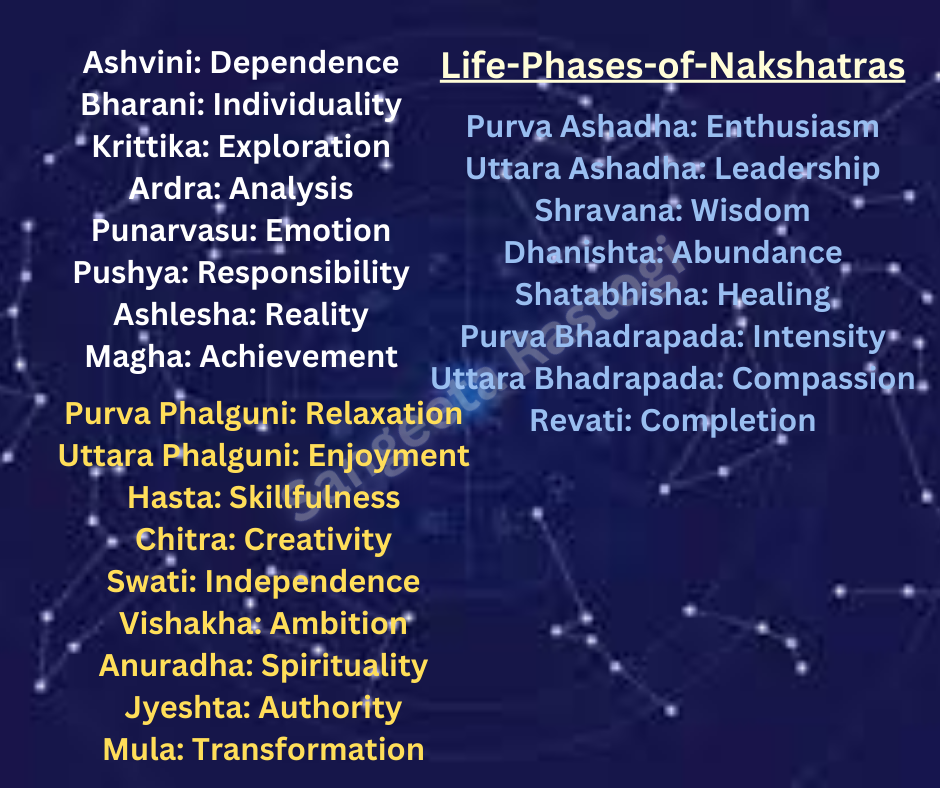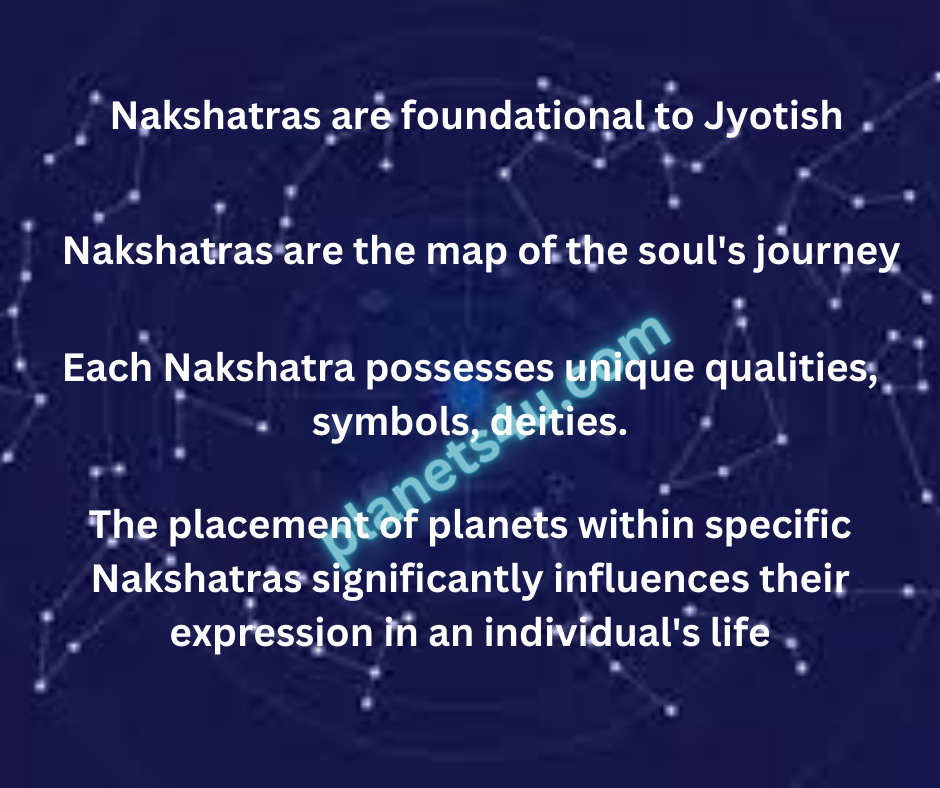Explore the 27 nakshatras in Vedic astrology, unveiling their deities, planetary rulers and key characteristics.

Nakshatras the energy transmitters: 27 Nakshatras in vedic astrology
Ashvini Nakshatra (0°00′ – 13°20′ Aries)
Beginnings, healing, impulsiveness, pioneering spirit, independence.
Ruled by Ketu, connected to Ganesha and the Ashvini Kumaras (divine physicians).
Bharani Nakshatra (13°20′ – 26°40′ Aries)
Passion, extremes, breaking taboos, transformative energy, sexuality.
Ruled by Venus, connected to the feminine principle and the cycle of birth and renewal.
Krittika Nakshatra (26°40′ Aries – 10°00′ Taurus)
Nurturing, purification, learning, knowledge, maternal instincts.
Ruled by Sun, connected to Kartikeya (son of Shiva and Parvati).
Rohini Nakshatra (10°00′ – 23°20′ Taurus)
Material abundance, sensuality, beauty, growth, pleasure.
Ruled by Moon, connected to Brahma and the Earth element.
Mrigashira Nakshatra (23°20′ Taurus – 6°40′ Gemini)
Curiosity, seeking, intellectual exploration, communication, sensitivity.
Ruled by Mars, connected to Soma (the nectar aspect of the Moon) and Parvati (wife of Shiva).
Ardra Nakshatra (6°40′ – 20°00′ Gemini)
Transformation, storms, intellectual power, mental agility, hidden emotions.
Ruled by Rahu, connected to Rudra (the destructive and transformative aspect of Shiva).
Punarvasu Nakshatra (20°00′ Gemini – 3°20′ Cancer)
Renewal, new beginnings, nurturing, healing, generosity.
Ruled by Jupiter, connected to Aditi (mother of the gods) and the concept of returning to the source.
Pushya Nakshatra (3°20′ – 16°40′ Cancer)
Nurturing, nourishment, growth, prosperity, patience.
Ruled by Saturn, connected to Brihaspati (the preceptor of the gods) and the Moon.
Ashlesha Nakshatra (16°40′ Cancer – 20°00′ Leo)
Hidden agendas, manipulation, intense focus, deep emotions, healing.
Ruled by Mercury, connected to the serpent deity Naga and the kundalini energy.
Magha Nakshatra (0°00′ – 13°20′ Leo)
Power, authority, leadership, legacy, ancestral influence.
Ruled by Ketu, connected to the Pitris (ancestors) and the concept of lineage.
Purva Phalguni Nakshatra (13°20′ – 26°40′ Leo)
Creativity, passion, romance, playfulness, generosity.
Ruled by Venus, connected to Bhaga (god of good fortune and prosperity).
Uttara Phalguni Nakshatra (26°40′ Leo – 10°00′ Virgo)
Generosity, kindness, helpfulness, leadership, marriage.
Ruled by Sun, connected to Aryaman (a solar deity associated with nobility and friendship).
Hasta Nakshatra (10°00′ – 23°20′ Virgo)
Skillfulness, dexterity, craftsmanship, communication, practicality.
Ruled by Moon, connected to Savitr (a solar deity associated with skill and inspiration).
Chitra Nakshatra (23°20′ Virgo – 6°40′ Libra)
Creativity, beauty, artistry, illusion, transformation.
Ruled by Mars, connected to Vishwakarma (the celestial architect) and Tvastar (a solar deity associated with craftsmanship).
Swati Nakshatra (6°40′ – 20°00′ Libra)
Independence, freedom, travel, trade, communication, diplomacy.
Ruled by Rahu, connected to Vayu (the wind god), associated with the planet Venus in its higher aspect.
Vishakha Nakshatra (20°00′ Libra – 3°20′ Scorpio)
Ambition, determination, focus, competition, celebration.
Ruled by Jupiter, connected to Indra (king of the gods) and Agni (god of fire), influenced by Venus and Mars.
Anuradha Nakshatra (3°20′ – 16°40′ Scorpio)
Devotion, friendships, healing, service to others, seeking truth.
Ruled by Saturn, connected to Mitra (a solar deity associated with friendship and alliances).
Jyeshta Nakshatra (16°40′ Scorpio – 0°00′ Sagittarius)
Leadership, ambition, protection, responsibility, pride.
Ruled by Mercury, connected to Indra (king of the gods) and the concept of seniority.
Mula Nakshatra (0°00′ – 13°20′ Sagittarius)
Research, getting to the root of things, destruction, transformation, spirituality.
Ruled by Ketu, connected to Nritti (goddess of dissolution and destruction).
Purva Ashadha Nakshatra (13°20′ – 26°40′ Sagittarius)
Inspiration, enthusiasm, purification, seeking knowledge, expansion.
Ruled by Venus, connected to Apah (water deity) and the concept of invigoration.
Uttara Ashadha Nakshatra (26°40′ Sagittarius – 10°00′ Capricorn)
Responsibility, leadership, victory, perseverance, following one’s dharma.
Ruled by Sun, connected to the Vishvadevas (universal gods) and Ganesha.
Shravana Nakshatra (10°00′ – 23°20′ Capricorn)
Learning, knowledge, communication, listening, connecting to higher wisdom.
Ruled by Moon, connected to Vishnu, Saraswati (goddess of learning), and the ability to hear divine messages.
Dhanishta Nakshatra (23°20′ Capricorn – 6°40′ Aquarius)
Abundance, prosperity, music, rhythm, fame, ambition.
Ruled by Mars, connected to the eight Vasus (celestial deities), influenced by Saturn.
Shatabhisha Nakshatra (6°40′ – 20°00′ Aquarius)
Healing, purification, isolation, secrets, mysticism, research.
Ruled by Rahu, connected to Varuna (god of the oceans), influenced by Saturn.
Purva Bhadrapada Nakshatra (20°00′ Aquarius – 3°20′ Pisces)
Transformation, intensity, destructive tendencies, seeking truth, spirituality.
Ruled by Jupiter, connected to Ajaikapada (a fiery deity), influenced by Saturn, .and Ketu.
Uttara Bhadrapada Nakshatra (3°20′ – 16°40′ Pisces)
Wisdom, spirituality, compassion, healing, letting go, connecting to the divine.
Ruled by Saturn, connected to Ahir Budhyana (a serpent deity), influenced by Jupiter and Ketu.
Revati Nakshatra (16°40′ Pisces – 30°00′ Pisces)
Abundance, prosperity, nourishment, completion, spirituality, connection to the divine.
Ruled by Mercury, connected to Pushan (a solar deity associated with nourishment and protection), influenced by Jupiter.
Nakshatras the energy transmitters: Your Questions Answered

Q1: What are Nakshatras
Nakshatras are lunar mansions in Vedic astrology. Vedic astrology uses the Moon’s placement through 27 Nakshatras to provide deeper insights into an individual’s life. Each Nakshatra spans 13°20′ of the zodiac, offering a more precise understanding of cosmic influences.
Q2: What is the role of the ruling deities in each Nakshatra?
Each Nakshatra is associated with a ruling deity, influencing its characteristics. For example, Ashvini is ruled by the Ashwini Kumaras, celestial healers known for their speed and rejuvenation powers. Understanding the deity associated with a Nakshatra can provide deeper insights into its mythology, symbolism and influence.
Q3: How do Nakshatras influence our understanding of life’s purpose and karmic patterns?
Nakshatras offer a framework for understanding our soul’s journey and karmic tendencies. They provide clues about our strengths, challenges and the lessons we are meant to learn in this lifetime. Analyzing the Nakshatras prominent in a birth chart can illuminate our soul’s evolutionary path and purpose.
Q4: What is the significance of the 28th Nakshatra, Abhijit and why is it not always included in traditional texts?
Abhijit, considered the 28th Nakshatra, is not a fixed Nakshatra like the other 27. It represents a special segment of the zodiac (0-12 degrees of Capricorn) associated with victory and accomplishment. Abhijit is often omitted in calculations as it doesn’t occupy a full 13°20′ segment. However, it holds special significance, representing a time of heightened energy and success.

deities for each of the 27 Nakshatras
Ashvini: Ashvini Kumaras (the twin physicians of the Gods), Brahma
Bharani: Yama (God of death), Kali (the dark Goddess), and fertility goddesses
Krittika: Karttikeya (the six-headed warrior God)
Rohini: Brahma
Mrigashira: Soma (Moon God) and Parvati
Ardra: Rudra (the storm God)
Punarvasu: Aditi (Mother of the Gods)
Pushya: Brihaspati (Guru of the Gods)
Ashlesha: Nagas (serpents)
Magha: Pitris (ancestors)
Purva Phalguni: Bhaga (God of prosperity and good fortune)
Uttara Phalguni: Aryaman (a solar deity)
Hasta: Savitar (the Sun God)
Chitra: Vishwakarma (the divine architect), Tvastar (the celestial artisan)
Swati: Vayu (the wind God)
Vishakha: Indra (king of the Gods) and Agni (fire God)
Anuradha: Mitra (God of friendship)
Jyeshta: Indra
Mula: Niritti (Goddess of destruction), Alakshmi (Goddess of misfortune)
Purva Ashadha: Apah (water God)
Uttara Ashadha: Ten Vishvadevas (Universal Gods) and Ganesha
Shravana: Vishnu
Dhanishta: Eight Vasus
Shatabhisha: Varuna (God of the oceans)
Purva Bhadrapada: Ajaikapada (a destructive form of Shiva), Rudra
Uttara Bhadrapada: Ahir Budhnya (serpent of the deep ocean) and Vishnu
Revati: Pushan (a solar deity)
Feel free to check out my YouTube page for more insightful contents. You can find it at Youtube. Additionally, if you’re interested in scheduling a consultation or contacting me for further inquiries, please visit my website where you can find my contact details. I look forward to connecting with you and providing the guidance you seek.
www.planets4u.com

